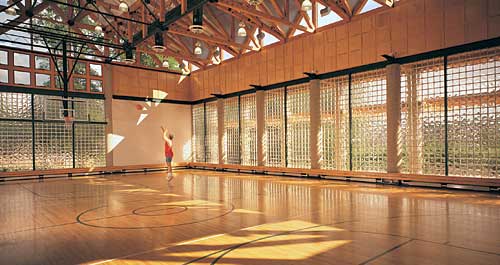Designing With Glass Block: Abundant Applications Provide Practical, Aesthetic and Green Solutions
Learning Objectives:
- Identify the structural properties of glass block when used as a building material.
- Discuss the unique performance abilities of glass block, such as fire protection, heat and light transmission, sound resistance, vandal resistance, and hurricane and earthquake resistance.
- Assess some of the economic and aesthetic implications of specifying glass block in specific building projects.
Credits:
Glass block is a unique building material. It has a dynamic relationship with light-both natural and artificial. As light changes so do the material's appearance and the surrounding environment. A great range of light and privacy is available depending on the pattern and transparency of the glass block. Used creatively, this building material can produce dramatic aesthetic effects.
The transparency of light depends on the pattern of glass block used. The results range from maximum light transmission to increasing degrees of privacy. Even with the most opaque block, or when using glass blocks as accent pieces, the result is the same--a visual connection from inside to out, or connecting to inside spaces. This sensory stimulant offers more than just aesthetics--it is considered a necessary component of a psychological and physiological healthful living and working environment. This brick made of glass also provides energy efficiencies, sound control, security and even visual texture. Today, with the growing commitment to green building, its properties and benefits may contribute to U.S. Green Building Council (USGBC) LEED® (Leadership in Energy and Environmental Design) certifications.
Glass block can be used in residential as well as commercial projects, as non-load bearing walls, windows, or partitions. An astonishing range of applications is possible with a corresponding variety of aesthetic results. Glass block have been used in police stations, subway terminals, schools, parking garages and gymnasiums, in addition to numerous private and commercial new construction and renovations. Consider some interior uses: as a contemporary shower stall, a kitchen island or backsplash, or as the sidelights at the front door. Yet, before building aesthetics and even design can be considered, it is crucial to become familiar with the technical properties of glass block. Working with glass block requires a certain level of skill and a thorough understanding of the material.
Structural Properties
Glass block is manufactured through a simple, yet exacting process. Silica sand, soda ash, and limestone are mixed and melted in tanks heated to 2,300 degrees Fahrenheit. From those tanks a precise amount of molten glass is poured into a half-block mold. Two halves are sealed together, creating a partial vacuum within the unit, and then fed into an oven (called a lehr) to slowly cool and, in the process, strengthen. This is the annealing process. Each block is then treated with a special edge coating of polyvinyl butyral to increase mortar bond and allow for expansion and contraction. Each block is tested for clarity and consistency.
Â
Â
Â
|
Â
The unit can be hollow or solid and come in a variety of sizes, shapes, patterns, and textures. The most commonly used units are square (6-, 8-, or 12-inch sizes). Rectangular units (4x8-inch and 6x8-inch) are also available, as are bull-nosed edge blocks for finishing horizontal and vertical panels, and various corner and angular blocks.
What makes the choice of block all the more interesting is the wide range of patterns. Clear block with its smooth face offers high visibility and light transmission. Wavy and fluted patterns allow for moderate levels of visual privacy while maintaining high light levels. Even greater privacy comes with stippled, diamond, and tightly ribbed designs. Fibrous glass inserts are also available to provide maximum privacy and further temper light and heat transmission.
Since glass block is made of glass and typically bonded together with mortar, it does not require any maintenance or special care. The durability is therefore exceptional because of the thickness of the faces and mortar bonding of the blocks. Unlike a typical glazing system or window, whereby the whole glass pane requires replacement upon damage, breakage in a glass block wall or window typically only requires a single block replacement. Many installations are over 50 years old, well beyond the typical life cycle of a window. This represents a considerable savings in material and maintenance.
Â










